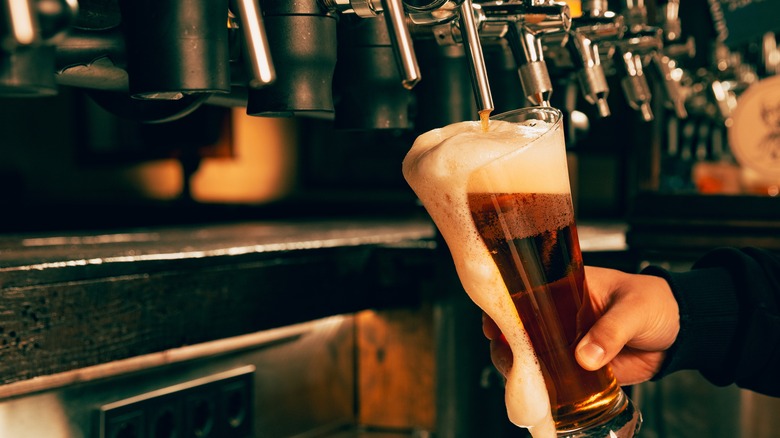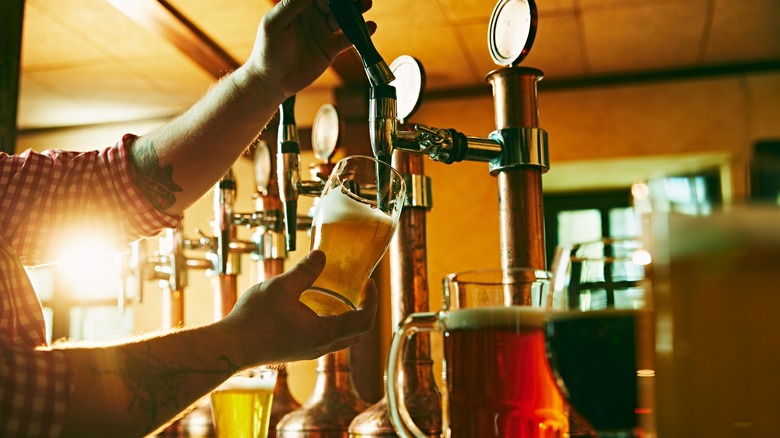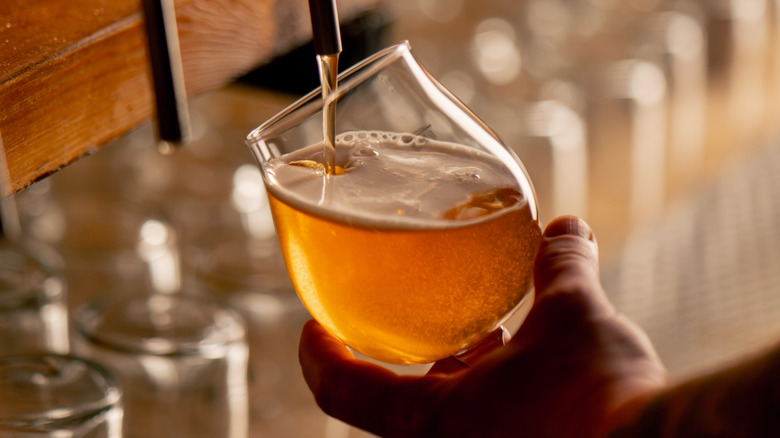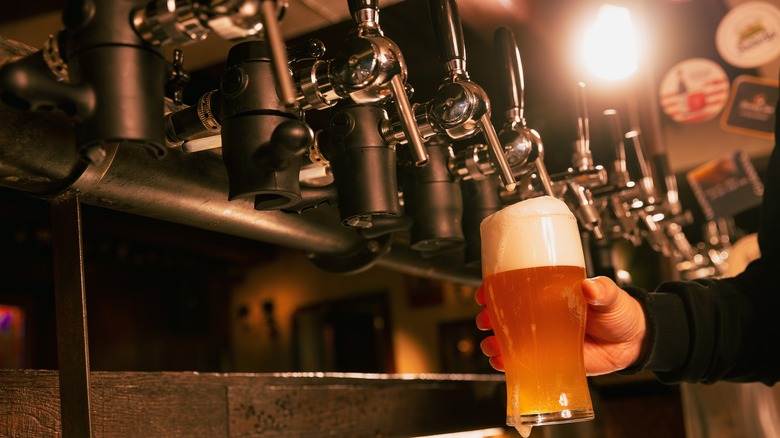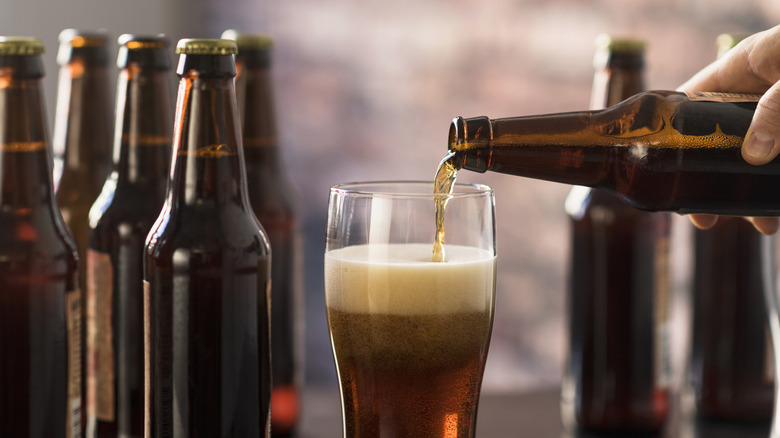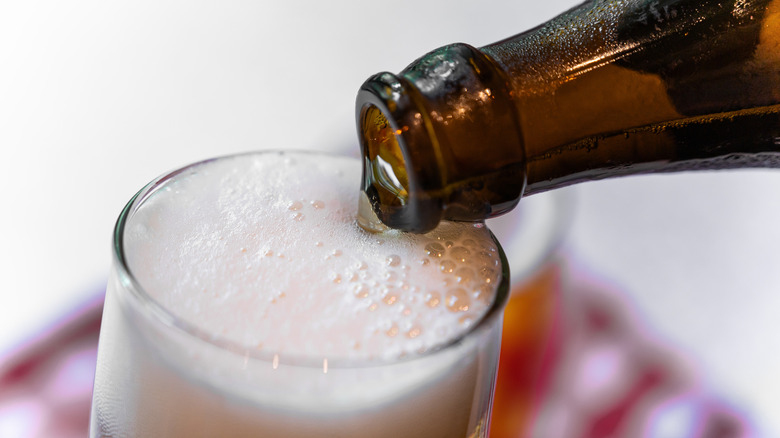5 Beer Pouring Techniques To Achieve The Perfect Head
Beer is easily the world's most beloved drink and one of the oldest human-produced beverages. It is universally a symbol of celebration and festivity with a rich culture of customs and practices involved in its consumption, including pouring techniques. The earliest beer hand pump was invented in the U.K. by an engineer named Joseph Bramah. The device engineered to pump beer from the keg into a glass was patented in 1785. Modern-day pressurized kegs made their debut in the early 1900s and have been the standard mechanism for pouring beer ever since. Many of us are probably pouring beer the wrong way, but learning a new technique is an opportunity to experience our favorite drink how it was meant to be enjoyed.
The term beer head refers to the frothy layer that forms at the top of your beer due to bubbles of carbon dioxide rising to the surface. It's also sometimes referred to as the collar or simply as beer foam. Mastering the perfect pour technique can enhance the beer's aroma, preserve the beer's integrity, ensure the right amount of foam, and achieve optimum carbonation levels. The specific technique required for the perfect pour depends on the type of beer being consumed. It's essential to start any pour with a clean, chilled glass. Soap residue or debris will affect your beverage's head, taste, and quality. Each technique will achieve a different quality and can be used in combination with others for the desired effect.
The tilted glass technique
The tilted glass pour technique requires tilting your glass at a 45-degree angle at the beginning of the pour. This technique allows the beer to pour down the slanted side of the glass and into the bottom of the cup. The tilt of the glass should be exactly halfway between the upright and the horizontal position for this technique to be most effective. Once the beer has started accumulating in the bottom, tilt the glass up slowly until the liquid reaches the top of the glass and finish with the glass positioned upright beneath the spout.
This technique reduces the amount of foam in the glass because the tilt creates a shorter distance for the CO2 to travel out of the glass. The beer also flows into the glass at a lower velocity when poured down the side rather than pouring it in upright. This pouring technique is ideal if you want more liquid to enjoy rather than foam inside of your glass.
The two-thirds and straighten technique
The two-thirds and straighten technique is a combination of the tilted glass and the straight-down technique. It is the best of both worlds because it allows a lower level of foam into the glass while still allowing some foam to accumulate. Begin this pour with the glass tilted at a 45-degree angle, allowing the beer to flow down the incline. Keep the glass inclined this way only until the beer is ⅔ of the way up the glass.
Once the beer reaches this mark, stand the glass upright to finish the pour. The beer will flow straight down the center of the upright glass and begin to agitate the liquid, releasing CO2 into the liquid. Releasing the CO2 will create a thin layer of foam at the finish of the pour, giving you a nice head at the top of the glass and plenty of liquid gold to enjoy.
The straight-down pour technique
The straight-down technique is perhaps the least complicated of the pours. It involves holding the glass upright directly under the tap, allowing the beer to flow into the glass and agitate the liquid, releasing plenty of CO2 throughout the fluid. The abundance of CO2, in combination with the consistent agitation created by this method, results in a significant amount of foam at the top of your glass. This method is ideal for achieving a thick, frothy head for those of you who enjoy accessorizing with a yummy beer foam mustache. I mean, nothing says good beer like a nice foam-filled mustache.
The link between beer foam and facial hair is so apparent that the Great American Beer Festival is jokingly known as the Great American Beard Festival due to its tendency to attract attendees with an excessive amount of facial hair. The fact that beards are a celebrated staple in beard culture may be a coincidence, or maybe it's the fact that a thick stache is the perfect place to hold a good head of beer foam which is achieved via the straight-down pour technique.
The hard and slow techniques
Pouring beer from bottles slightly differs from pouring beer from the tap and certain types of beer will require specific techniques. True beer nerds will tell you that nitro beers have a completely different set of rules due to the fact that they contain more nitrogen than CO2. Nitrogen makes a much fluffier foam, so nitro beers must be poured with a hard pour technique. To master the hard pour, turn the open bottle of beer straight upside down into the glass and lift the bottle as the glass fills. This pour will leave mostly foam in the glass, but since nitro beers are not highly carbonated, the foam will quickly dissipate into fluid.
The 5-minute pour is best for pilsners, a German pale lager. The slow pour releases CO2 gently, making the beer softer and the head of foam at the top thick like whipped cream. To employ the slow pour technique, simply pour the beer into the glass in short intervals with the glass titled at an angle. Allow time between each pour for the foam to build up and settle.
CO2 and your brew
The magic of a perfect pour technique bubbles down to good chemistry. Carbon dioxide is produced naturally by the brewing process and affects the taste, quality, and shelf life of the beverage. Additional CO2 is injected into certain types of brews once the initial fermentation is complete to reach the required carbonation levels. Other brews get a secondary fermentation initiated by introducing additional sugar into the brew. The science behind brewing different types of beer can be helpful to understand when you are deciding which pour technique to use for pouring your own brews.
Pour your own beer bars are becoming a popular trend in many cities, meaning more opportunities to practice your technique. My favorite pour-your-own beer bar in Kansas City is called Taps on Main. The bar issues customers a tap card to use at the beer wall, where they insert the card to keep tabs on how much beer is poured. The beer wall is like a beer buffet where you pay per ounce. Customers must get a new glass for each pour, and the bar offers a range of cup sizes. I like getting the tiny sample-size glass and creating a flight of beers I've never tried. Whether you're sampling from the beer wall or pouring a toast to life with loved ones at home, a good pour technique can enhance your celebration.
